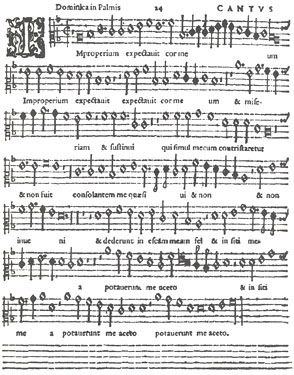About
Renaissance Sacred Music
"A music so
pure, so spiritual, so connected, so calm, that mere words cannot explain it. Its essence
is a rare, refined celestial beauty that resonates within the listener to such an extent
that the presence of angels is felt, and the spirit of the divine is sensed, all with a
magnificently peaceful grandeur. If I had but only one composer to listen to on a remote
island for the rest of my life, that composer would be Tomas Luis de Victoria."
Don Robertson
| The renaissance period in Western
European culture is generally recognized as very roughly spanning the years between
1400 and 1600. The
sacred music composed during this period was composed for the Roman Catholic Church. Much
of this great body of music has survived today in manuscripts that were used in the great
cathedrals and monasteries of Europe. Some instruments may have been employed, but the
music was |
 |
|
written primarily for a cappella choir (without instruments). Basically,
renaissance sacred music was an extension of Gregorian chant, a style music that was also
unaccompanied by instruments. The texts were the same that were used in Gregorian chant:
the Roman liturgy, sung in Latin. |
The great composers of the early
renaissance were Guillaume Dufay (c.1400-1474), Johannes Ockeghem (c.1410-1497), Jacob
Obrecht (1457-1505), and Josquin des Prez
(c.1440-1521). Many glorious masses
and motets (which were short liturgical compositions) have come down to us from these
great composers.
The great composers of the late
renaissance were Orlando di Lasso (also known as Orlandus
Lassus) (1532-1594), Jacob Handl
(also known as Jacobus Gallus) (1550-1591),
Giovanni Pierluigi da Palestrina (1525-1594),
and Tomas Luis de Victoria (1548-1611). These composers left a great body of works that
are truly a great treasure of Western civilization; however, Western civilization does not
know it. For this reason, there are few books, few web links. There have been a number of
fine CDs produced, which, in the final analysis, is the most important tribute that can be
made to this music.
About 1600, the baroque era began and
the style of music changed dramatically. The baroque era was followed by the romantic era
that lasted roughly until the beginning of the 20th Century. Today many listeners of
Western classical music do not recognize renaissance sacred music as being a valid
classical music tradition. Music, supposedly, began with J.S.
Bach, or perhaps earlier with the
17th Century composer, Claudio
Monteverdi. This tremendous oversight1 can be brought into clearer
perspective when one realizes that just over a hundred years ago, listeners in Europe were
largely unfamiliar even with the music of Bach.
The style of the great sacred music of
the renaissance period is tremendously out of sync with contemporary culture. A music that
has no instruments and, according to the average and casual listener, a music without any
distinctive character, would be no match to the electronically enhanced sounds of
contemporary music. However, renaissance sacred music has much to offer to those who have
realized the limitations of much of today's music and are ready to move on. Once one has
become intimately familiar with the sacred music of the renaissance, it becomes obvious
that this is a period of musical culture that should have never been forgotten and
neglected by contemporary society.
The world has yet to discover the lost
music of the renaissance. When this music is finally accepted by spiritually minded souls
of all nationalities and cultures, it will be a great day. What a treasure this music is,
buried in the back shelves of our larger university libraries.
Additional
Reading ->
The
Music of Holy Week
->
The Liturgical Year
Da
Vinci, Rafael, Michelangelo...a dozen or so artists are
recognized as great masters during the time of the Italian
Renaissance. Why has not the same recognition been afforded
the composers that were also great masters of renaissance art
during the same period?
|

